ACCT20073 Corporate Accounting Assignment: Fair Value and CGUs
VerifiedAdded on 2022/10/04
|7
|1340
|35
Homework Assignment
AI Summary
This assignment solution addresses key concepts in corporate accounting, focusing on fair value measurement according to IFRS 13 and AASB 13, impairment testing, and cash generating units (CGUs). The solution explains the provisions of IFRS 13 related to fair valuation of assets and liabilities, the market participant assumptions, and the application of fair value techniques. It also discusses the principles of GAAP regarding depreciation and asset valuation, contrasting the cost model with the fair value model. Furthermore, the assignment explores impairment testing processes, the role of CGUs, and the constraints in determining them, using the example of the Saferide bus Company. The solution provides detailed explanations and references to relevant accounting standards and literature.
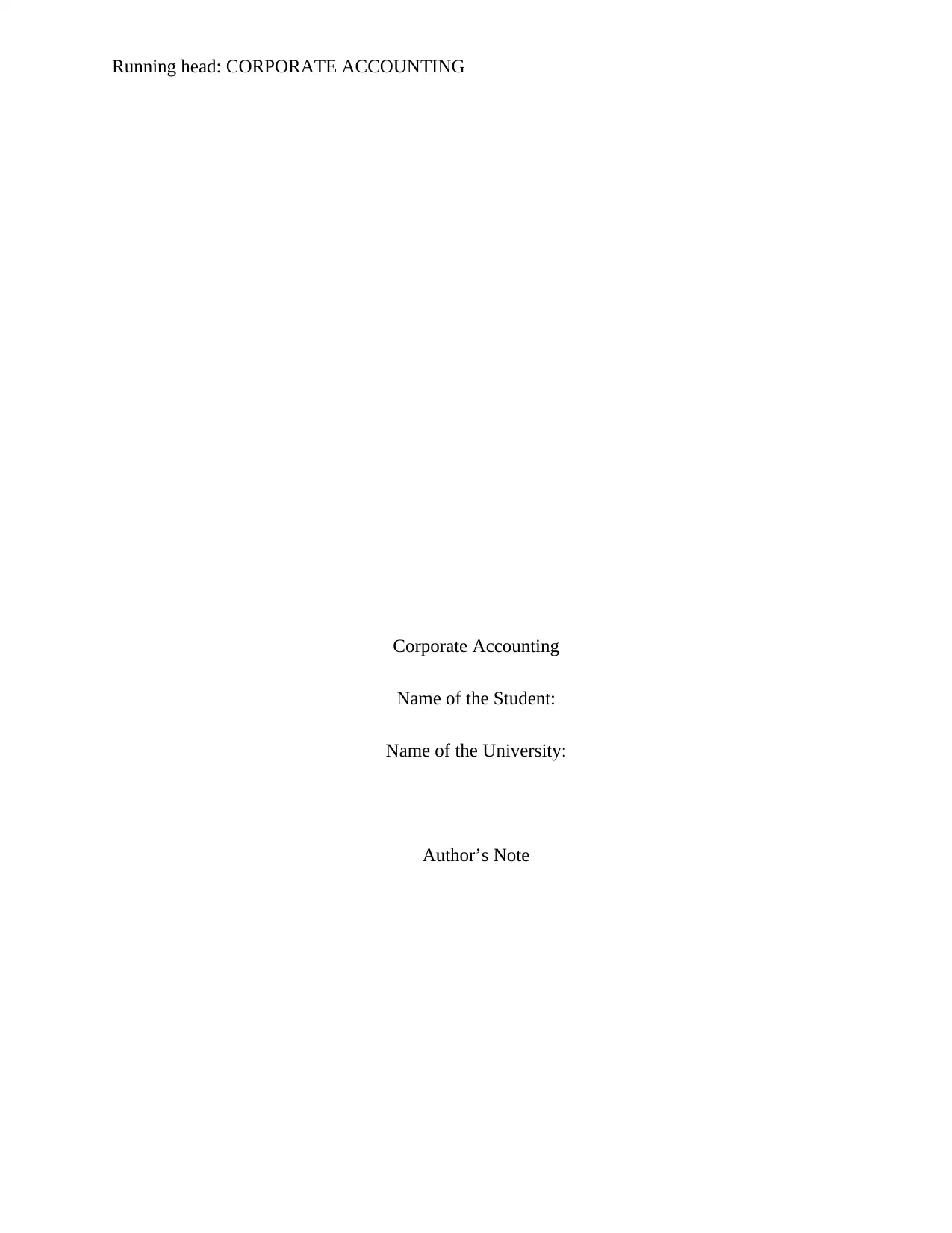
Running head: CORPORATE ACCOUNTING
Corporate Accounting
Name of the Student:
Name of the University:
Author’s Note
Corporate Accounting
Name of the Student:
Name of the University:
Author’s Note
Paraphrase This Document
Need a fresh take? Get an instant paraphrase of this document with our AI Paraphraser
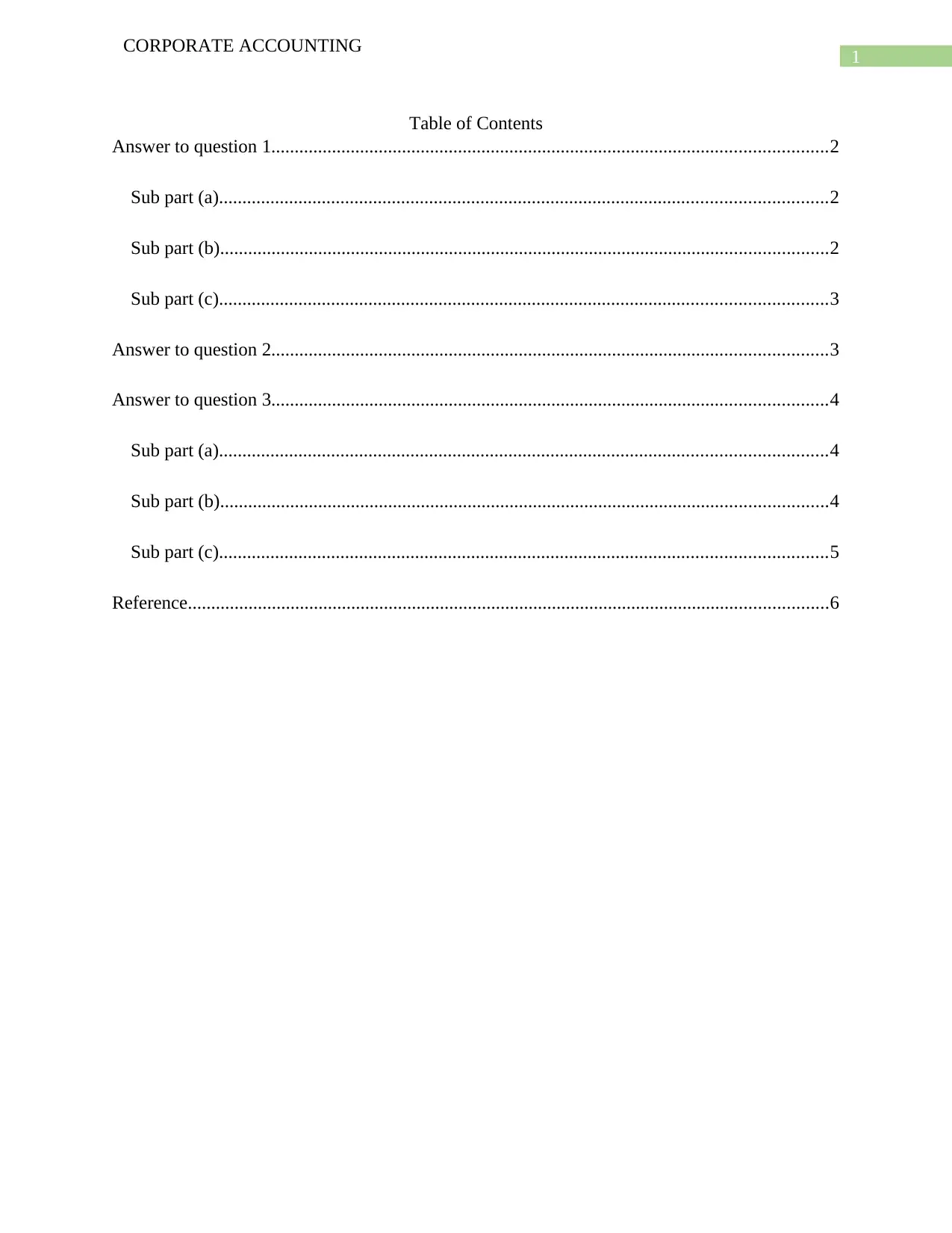
1
CORPORATE ACCOUNTING
Table of Contents
Answer to question 1.......................................................................................................................2
Sub part (a)..................................................................................................................................2
Sub part (b)..................................................................................................................................2
Sub part (c)..................................................................................................................................3
Answer to question 2.......................................................................................................................3
Answer to question 3.......................................................................................................................4
Sub part (a)..................................................................................................................................4
Sub part (b)..................................................................................................................................4
Sub part (c)..................................................................................................................................5
Reference.........................................................................................................................................6
CORPORATE ACCOUNTING
Table of Contents
Answer to question 1.......................................................................................................................2
Sub part (a)..................................................................................................................................2
Sub part (b)..................................................................................................................................2
Sub part (c)..................................................................................................................................3
Answer to question 2.......................................................................................................................3
Answer to question 3.......................................................................................................................4
Sub part (a)..................................................................................................................................4
Sub part (b)..................................................................................................................................4
Sub part (c)..................................................................................................................................5
Reference.........................................................................................................................................6
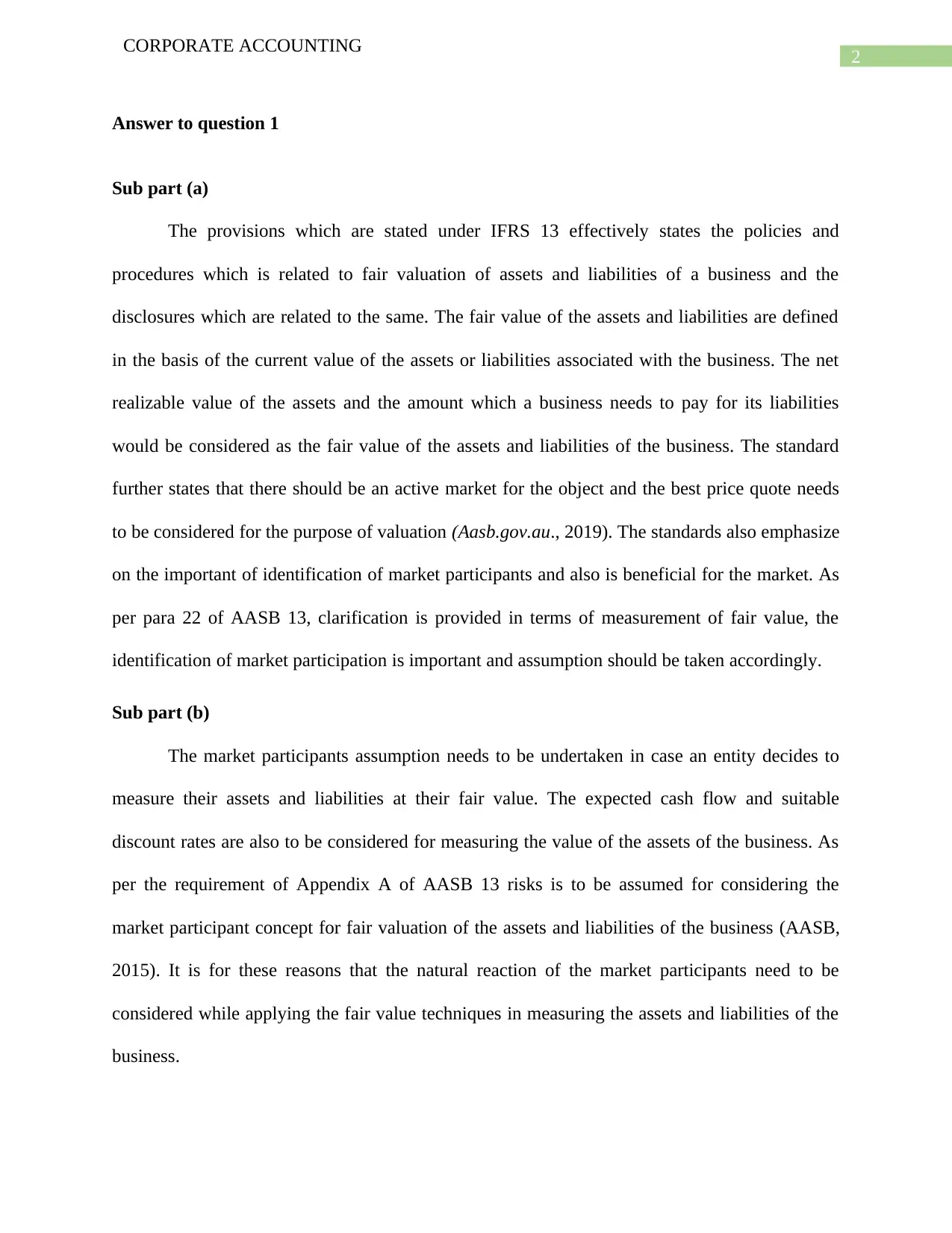
2
CORPORATE ACCOUNTING
Answer to question 1
Sub part (a)
The provisions which are stated under IFRS 13 effectively states the policies and
procedures which is related to fair valuation of assets and liabilities of a business and the
disclosures which are related to the same. The fair value of the assets and liabilities are defined
in the basis of the current value of the assets or liabilities associated with the business. The net
realizable value of the assets and the amount which a business needs to pay for its liabilities
would be considered as the fair value of the assets and liabilities of the business. The standard
further states that there should be an active market for the object and the best price quote needs
to be considered for the purpose of valuation (Aasb.gov.au., 2019). The standards also emphasize
on the important of identification of market participants and also is beneficial for the market. As
per para 22 of AASB 13, clarification is provided in terms of measurement of fair value, the
identification of market participation is important and assumption should be taken accordingly.
Sub part (b)
The market participants assumption needs to be undertaken in case an entity decides to
measure their assets and liabilities at their fair value. The expected cash flow and suitable
discount rates are also to be considered for measuring the value of the assets of the business. As
per the requirement of Appendix A of AASB 13 risks is to be assumed for considering the
market participant concept for fair valuation of the assets and liabilities of the business (AASB,
2015). It is for these reasons that the natural reaction of the market participants need to be
considered while applying the fair value techniques in measuring the assets and liabilities of the
business.
CORPORATE ACCOUNTING
Answer to question 1
Sub part (a)
The provisions which are stated under IFRS 13 effectively states the policies and
procedures which is related to fair valuation of assets and liabilities of a business and the
disclosures which are related to the same. The fair value of the assets and liabilities are defined
in the basis of the current value of the assets or liabilities associated with the business. The net
realizable value of the assets and the amount which a business needs to pay for its liabilities
would be considered as the fair value of the assets and liabilities of the business. The standard
further states that there should be an active market for the object and the best price quote needs
to be considered for the purpose of valuation (Aasb.gov.au., 2019). The standards also emphasize
on the important of identification of market participants and also is beneficial for the market. As
per para 22 of AASB 13, clarification is provided in terms of measurement of fair value, the
identification of market participation is important and assumption should be taken accordingly.
Sub part (b)
The market participants assumption needs to be undertaken in case an entity decides to
measure their assets and liabilities at their fair value. The expected cash flow and suitable
discount rates are also to be considered for measuring the value of the assets of the business. As
per the requirement of Appendix A of AASB 13 risks is to be assumed for considering the
market participant concept for fair valuation of the assets and liabilities of the business (AASB,
2015). It is for these reasons that the natural reaction of the market participants need to be
considered while applying the fair value techniques in measuring the assets and liabilities of the
business.
⊘ This is a preview!⊘
Do you want full access?
Subscribe today to unlock all pages.

Trusted by 1+ million students worldwide
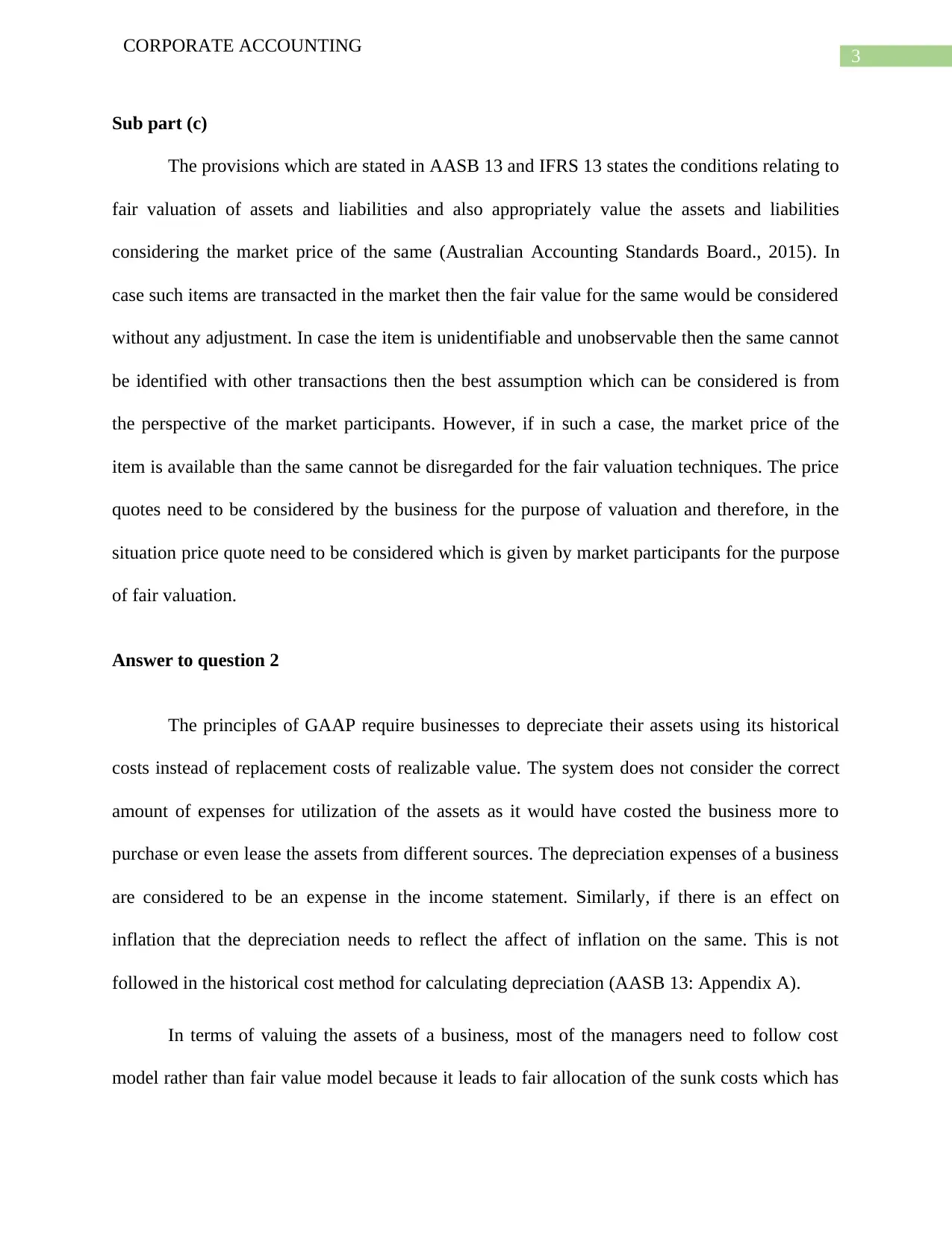
3
CORPORATE ACCOUNTING
Sub part (c)
The provisions which are stated in AASB 13 and IFRS 13 states the conditions relating to
fair valuation of assets and liabilities and also appropriately value the assets and liabilities
considering the market price of the same (Australian Accounting Standards Board., 2015). In
case such items are transacted in the market then the fair value for the same would be considered
without any adjustment. In case the item is unidentifiable and unobservable then the same cannot
be identified with other transactions then the best assumption which can be considered is from
the perspective of the market participants. However, if in such a case, the market price of the
item is available than the same cannot be disregarded for the fair valuation techniques. The price
quotes need to be considered by the business for the purpose of valuation and therefore, in the
situation price quote need to be considered which is given by market participants for the purpose
of fair valuation.
Answer to question 2
The principles of GAAP require businesses to depreciate their assets using its historical
costs instead of replacement costs of realizable value. The system does not consider the correct
amount of expenses for utilization of the assets as it would have costed the business more to
purchase or even lease the assets from different sources. The depreciation expenses of a business
are considered to be an expense in the income statement. Similarly, if there is an effect on
inflation that the depreciation needs to reflect the affect of inflation on the same. This is not
followed in the historical cost method for calculating depreciation (AASB 13: Appendix A).
In terms of valuing the assets of a business, most of the managers need to follow cost
model rather than fair value model because it leads to fair allocation of the sunk costs which has
CORPORATE ACCOUNTING
Sub part (c)
The provisions which are stated in AASB 13 and IFRS 13 states the conditions relating to
fair valuation of assets and liabilities and also appropriately value the assets and liabilities
considering the market price of the same (Australian Accounting Standards Board., 2015). In
case such items are transacted in the market then the fair value for the same would be considered
without any adjustment. In case the item is unidentifiable and unobservable then the same cannot
be identified with other transactions then the best assumption which can be considered is from
the perspective of the market participants. However, if in such a case, the market price of the
item is available than the same cannot be disregarded for the fair valuation techniques. The price
quotes need to be considered by the business for the purpose of valuation and therefore, in the
situation price quote need to be considered which is given by market participants for the purpose
of fair valuation.
Answer to question 2
The principles of GAAP require businesses to depreciate their assets using its historical
costs instead of replacement costs of realizable value. The system does not consider the correct
amount of expenses for utilization of the assets as it would have costed the business more to
purchase or even lease the assets from different sources. The depreciation expenses of a business
are considered to be an expense in the income statement. Similarly, if there is an effect on
inflation that the depreciation needs to reflect the affect of inflation on the same. This is not
followed in the historical cost method for calculating depreciation (AASB 13: Appendix A).
In terms of valuing the assets of a business, most of the managers need to follow cost
model rather than fair value model because it leads to fair allocation of the sunk costs which has
Paraphrase This Document
Need a fresh take? Get an instant paraphrase of this document with our AI Paraphraser
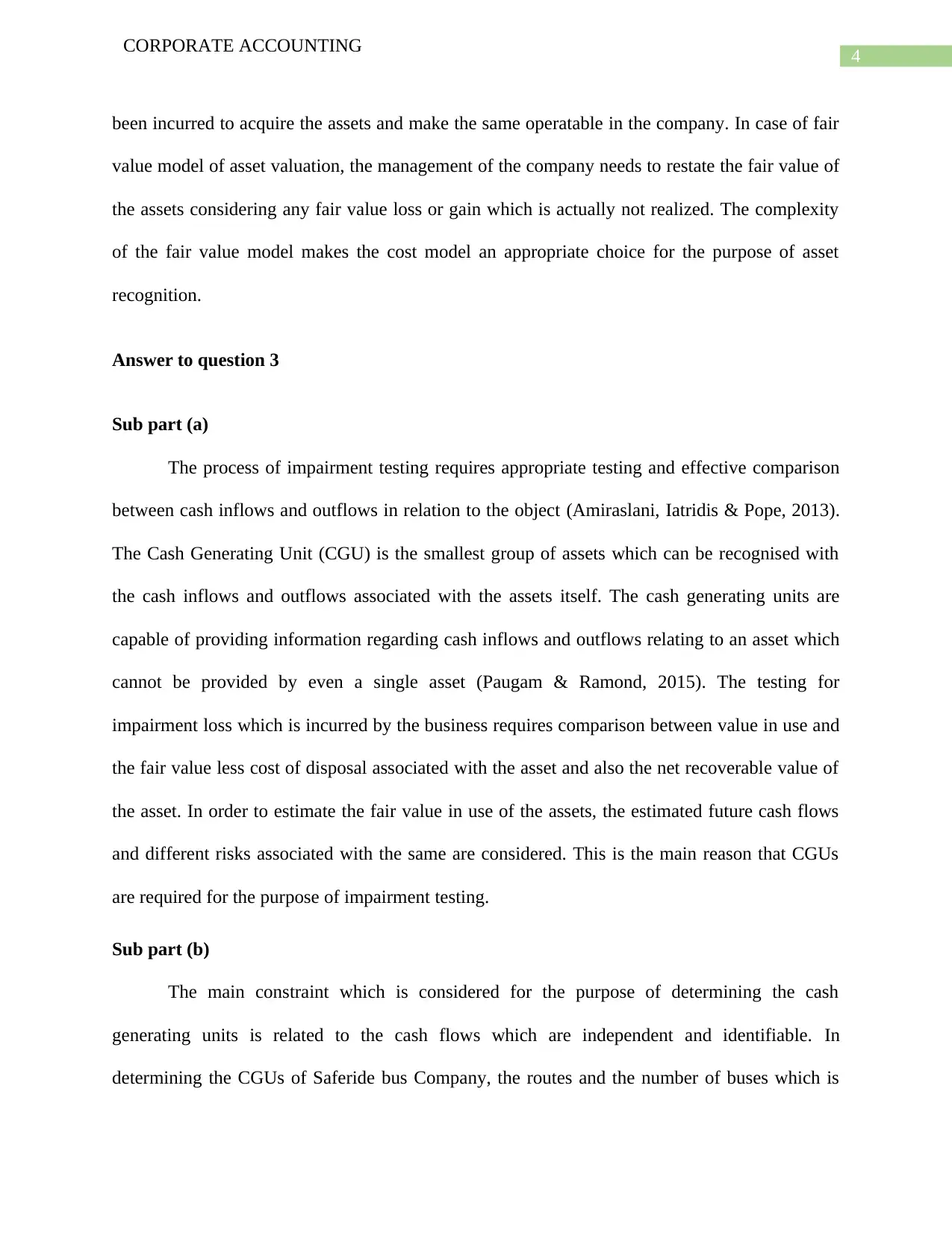
4
CORPORATE ACCOUNTING
been incurred to acquire the assets and make the same operatable in the company. In case of fair
value model of asset valuation, the management of the company needs to restate the fair value of
the assets considering any fair value loss or gain which is actually not realized. The complexity
of the fair value model makes the cost model an appropriate choice for the purpose of asset
recognition.
Answer to question 3
Sub part (a)
The process of impairment testing requires appropriate testing and effective comparison
between cash inflows and outflows in relation to the object (Amiraslani, Iatridis & Pope, 2013).
The Cash Generating Unit (CGU) is the smallest group of assets which can be recognised with
the cash inflows and outflows associated with the assets itself. The cash generating units are
capable of providing information regarding cash inflows and outflows relating to an asset which
cannot be provided by even a single asset (Paugam & Ramond, 2015). The testing for
impairment loss which is incurred by the business requires comparison between value in use and
the fair value less cost of disposal associated with the asset and also the net recoverable value of
the asset. In order to estimate the fair value in use of the assets, the estimated future cash flows
and different risks associated with the same are considered. This is the main reason that CGUs
are required for the purpose of impairment testing.
Sub part (b)
The main constraint which is considered for the purpose of determining the cash
generating units is related to the cash flows which are independent and identifiable. In
determining the CGUs of Saferide bus Company, the routes and the number of buses which is
CORPORATE ACCOUNTING
been incurred to acquire the assets and make the same operatable in the company. In case of fair
value model of asset valuation, the management of the company needs to restate the fair value of
the assets considering any fair value loss or gain which is actually not realized. The complexity
of the fair value model makes the cost model an appropriate choice for the purpose of asset
recognition.
Answer to question 3
Sub part (a)
The process of impairment testing requires appropriate testing and effective comparison
between cash inflows and outflows in relation to the object (Amiraslani, Iatridis & Pope, 2013).
The Cash Generating Unit (CGU) is the smallest group of assets which can be recognised with
the cash inflows and outflows associated with the assets itself. The cash generating units are
capable of providing information regarding cash inflows and outflows relating to an asset which
cannot be provided by even a single asset (Paugam & Ramond, 2015). The testing for
impairment loss which is incurred by the business requires comparison between value in use and
the fair value less cost of disposal associated with the asset and also the net recoverable value of
the asset. In order to estimate the fair value in use of the assets, the estimated future cash flows
and different risks associated with the same are considered. This is the main reason that CGUs
are required for the purpose of impairment testing.
Sub part (b)
The main constraint which is considered for the purpose of determining the cash
generating units is related to the cash flows which are independent and identifiable. In
determining the CGUs of Saferide bus Company, the routes and the number of buses which is
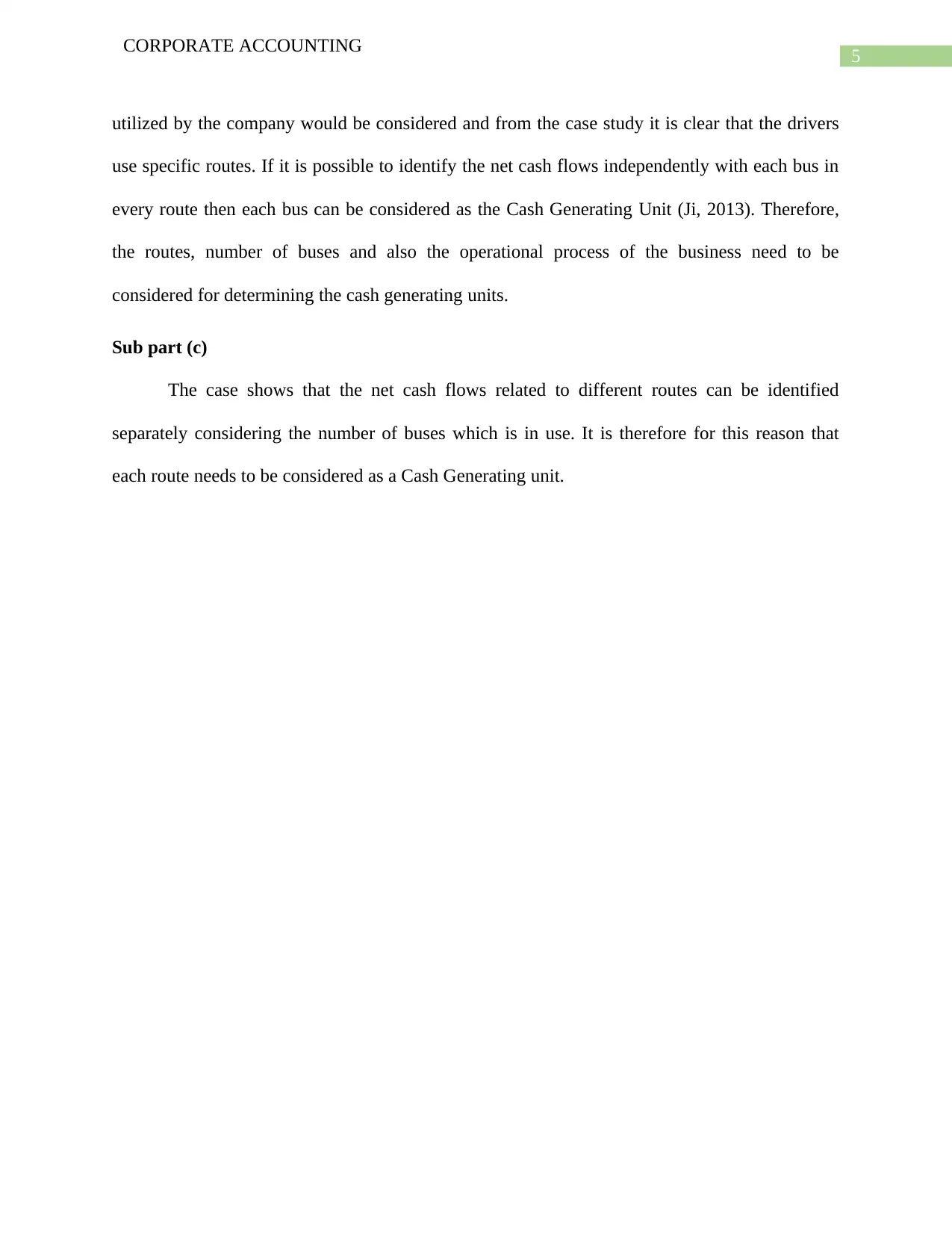
5
CORPORATE ACCOUNTING
utilized by the company would be considered and from the case study it is clear that the drivers
use specific routes. If it is possible to identify the net cash flows independently with each bus in
every route then each bus can be considered as the Cash Generating Unit (Ji, 2013). Therefore,
the routes, number of buses and also the operational process of the business need to be
considered for determining the cash generating units.
Sub part (c)
The case shows that the net cash flows related to different routes can be identified
separately considering the number of buses which is in use. It is therefore for this reason that
each route needs to be considered as a Cash Generating unit.
CORPORATE ACCOUNTING
utilized by the company would be considered and from the case study it is clear that the drivers
use specific routes. If it is possible to identify the net cash flows independently with each bus in
every route then each bus can be considered as the Cash Generating Unit (Ji, 2013). Therefore,
the routes, number of buses and also the operational process of the business need to be
considered for determining the cash generating units.
Sub part (c)
The case shows that the net cash flows related to different routes can be identified
separately considering the number of buses which is in use. It is therefore for this reason that
each route needs to be considered as a Cash Generating unit.
⊘ This is a preview!⊘
Do you want full access?
Subscribe today to unlock all pages.

Trusted by 1+ million students worldwide
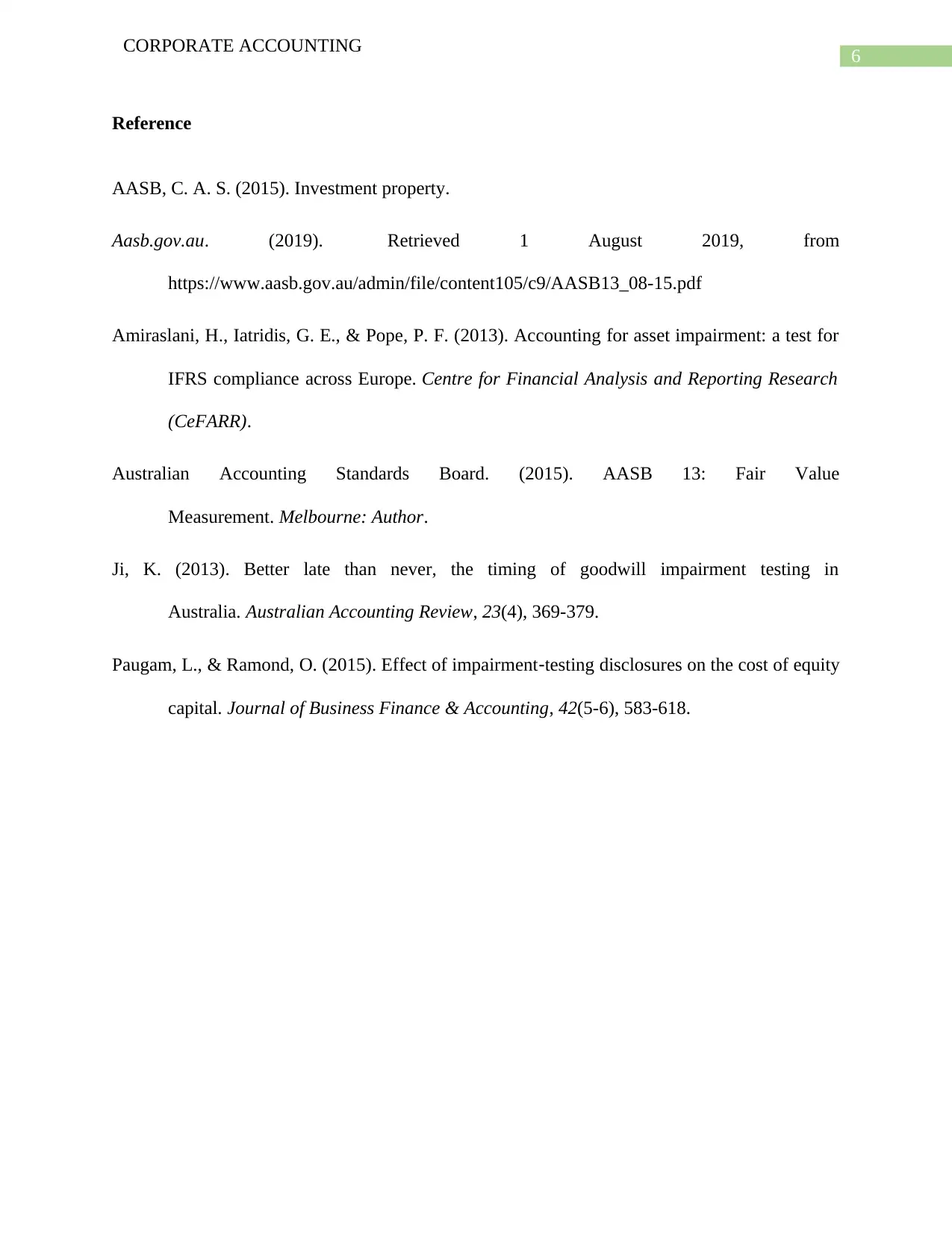
6
CORPORATE ACCOUNTING
Reference
AASB, C. A. S. (2015). Investment property.
Aasb.gov.au. (2019). Retrieved 1 August 2019, from
https://www.aasb.gov.au/admin/file/content105/c9/AASB13_08-15.pdf
Amiraslani, H., Iatridis, G. E., & Pope, P. F. (2013). Accounting for asset impairment: a test for
IFRS compliance across Europe. Centre for Financial Analysis and Reporting Research
(CeFARR).
Australian Accounting Standards Board. (2015). AASB 13: Fair Value
Measurement. Melbourne: Author.
Ji, K. (2013). Better late than never, the timing of goodwill impairment testing in
Australia. Australian Accounting Review, 23(4), 369-379.
Paugam, L., & Ramond, O. (2015). Effect of impairment‐testing disclosures on the cost of equity
capital. Journal of Business Finance & Accounting, 42(5-6), 583-618.
CORPORATE ACCOUNTING
Reference
AASB, C. A. S. (2015). Investment property.
Aasb.gov.au. (2019). Retrieved 1 August 2019, from
https://www.aasb.gov.au/admin/file/content105/c9/AASB13_08-15.pdf
Amiraslani, H., Iatridis, G. E., & Pope, P. F. (2013). Accounting for asset impairment: a test for
IFRS compliance across Europe. Centre for Financial Analysis and Reporting Research
(CeFARR).
Australian Accounting Standards Board. (2015). AASB 13: Fair Value
Measurement. Melbourne: Author.
Ji, K. (2013). Better late than never, the timing of goodwill impairment testing in
Australia. Australian Accounting Review, 23(4), 369-379.
Paugam, L., & Ramond, O. (2015). Effect of impairment‐testing disclosures on the cost of equity
capital. Journal of Business Finance & Accounting, 42(5-6), 583-618.
1 out of 7
Related Documents
Your All-in-One AI-Powered Toolkit for Academic Success.
+13062052269
info@desklib.com
Available 24*7 on WhatsApp / Email
![[object Object]](/_next/static/media/star-bottom.7253800d.svg)
Unlock your academic potential
Copyright © 2020–2025 A2Z Services. All Rights Reserved. Developed and managed by ZUCOL.





